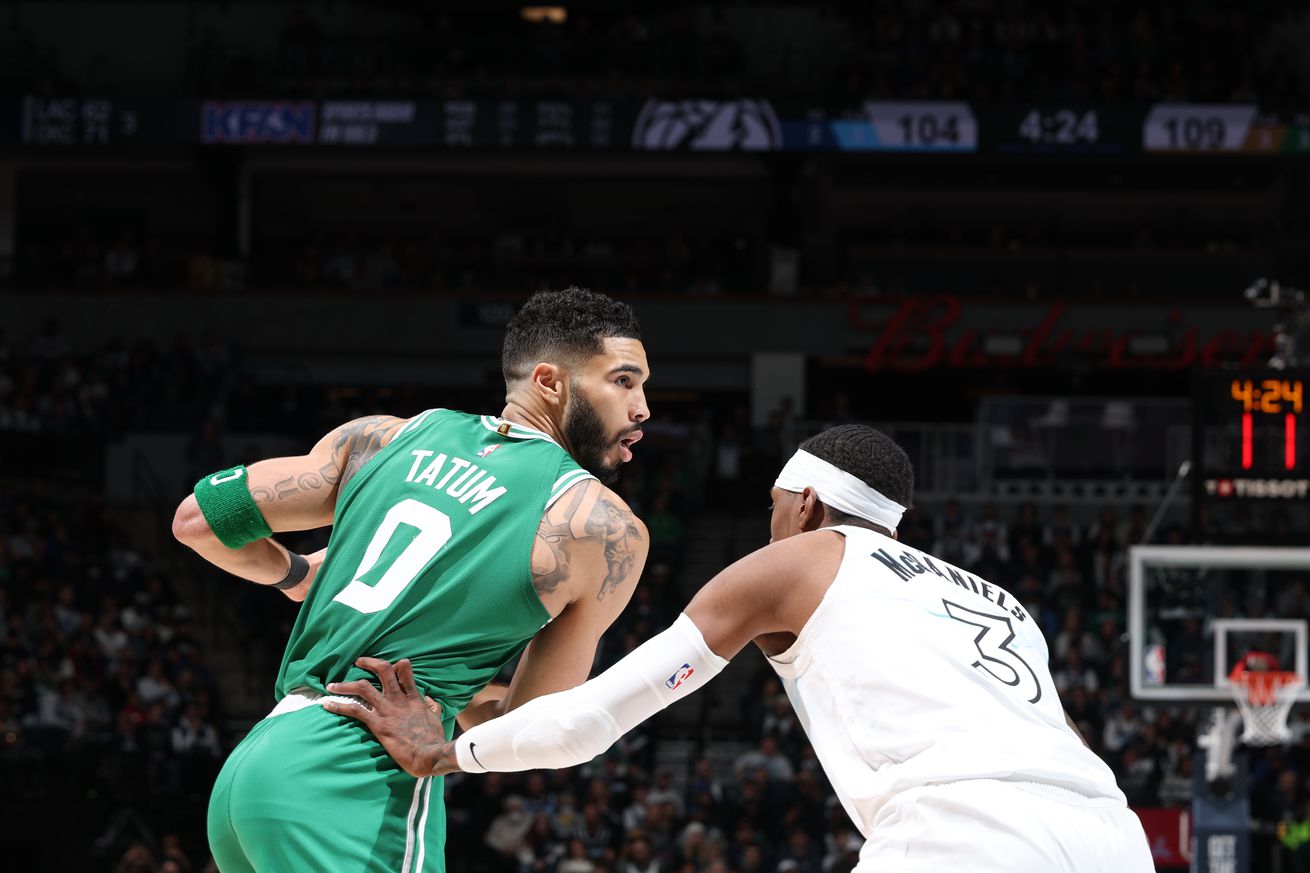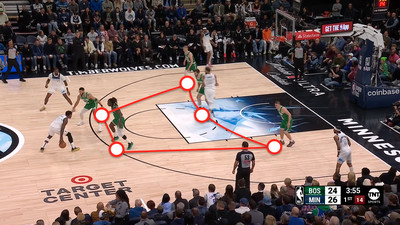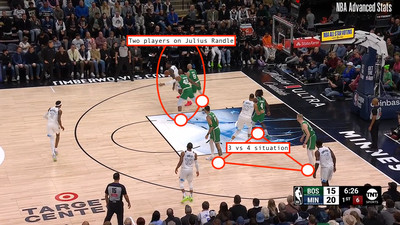
The Celtics ran sharp play calls to break down Minnesota’s defense, with smart screens and ball movement. On the other end, Boston’s defensive flexibility helped them adapt and generate turnovers despite some early lapses.
#1 – How to attack one of the best defenses in the NBA
There is no secret about it: the Timberwolves are one of the best defensive teams in the NBA. Their long wings, Rudy Gobert’s rim protection, and Anthony Edwards’ point-of-attack defense form an explosive cocktail. So, how do you attack such a defensive fortress? Well, Joe Mazzulla and his coaching staff had a few play calls that opened things up.
They ran the same baseline action twice—once in the first, once in the fourth. On both plays, they made Jayson Tatum start far from the ball to spread the defense as much as possible. At the same time, they ran staggered screens under the basket for Sam Hauser to attract two players onto the shooter.
On the first play, this opened up Al Horford for three, who swung it to JT, who also swung it to Jrue Holiday for an open three. On the second try, Queta was the second screener and used Hauser’s gravity to run to the rim and catch the alley-oop. Easy.
One set we are starting to see more often is an action where Al Horford sets a down screen and then a ram screen. This forces McDaniels to switch and leave Jayson Tatum open. Therefore, Gobert has to help, and Tatum can drive and find him at the rim.
The Celtics also used the same play the Dallas Mavericks spammed against the Timberwolves during the last playoffs: a double drag screen to pull Gobert out of the paint. The Frenchman is first switched onto Jayson Tatum, and then he has to switch onto Sam Hauser. The shooter dragged Gobert far from the rim, allowing Tatum to easily drive on Mike Conley.
Nice to see some play calls for Payton Pritchard too. It shows how much his status has evolved. On this play, the Celtics run a staggered action for him. He first looks like he’s setting a screen for Horford, but the veteran twirls in the middle of the action to reset a screen for Pritchard.
Payton ran towards the ball and had all the space needed to attack Mike Conley.
Yes, the Celtics are taking a lot of triples, but this shows how much more complex the game plan is. Great play call from the coaching staff and great execution from the players.
#2 – Defense falls asleep early
While facing one of the best defenses, the Celtics were a bit slow to react early in the game. The Timberwolves used a lot of Julius Randle post-ups to generate double teams and force the Celtics players to help off-ball.
Yet, the Celtics had a hard time keeping up with the ball movement at first. However, they showed great flexibility and adaptability on defense throughout the game.
#3 – Defensive flexibility
Sometimes, a picture is worth a thousand words. Last night gave a great example of the Celtics’ defensive flexibility. Jayson Tatum, a tall and long forward, is matched up with the ball-handler, while Jrue Holiday is taking care of Rudy Gobert, a center. On the pick-and-roll, they literally just have to switch, and the threat is canceled.
Following the switch on the ball, Tatum switches off-ball to keep Luke Kornet close to the basket, and the action ends in a difficult post-up attempt from Nickeil Alexander-Walker. Later in the game, we also saw the Celtics run a zone defense to punish the Wolves’ lack of shooting.

The Celtics displayed their defensive flexibility, adapting to the matchup. They also showed they could ramp up on the defensive playmaking following Joe Mazzulla’s comments on turnovers.
#4 – Defensive playmaking
On the broadcast, TNT’s Kevin Harlan and Stan Van Gundy couldn’t stop talking about Joe Mazzulla’s comments on the Celtics’ defense, focusing on the team’s lack of defensive playmaking. Indeed, the Celtics are good at forcing difficult shots but not the best when it comes to creating turnovers and fast breaks.
Well, over the last two games, the Celtics forced their opponents to lose the ball on more than 20% of their possessions. That’s far better than the season average of a 13% turnover rate from Celtics’ opponents. With Porzingis out, it’s not surprising to see the Celtics finding another way to defend the basket.
#5 – Jrue Holiday dilemma
In the first half of the game, the Wolves tried the double-big lineup with both Rudy Gobert and Naz Reid – and it didn’t go well. Indeed, as the Celtics’ only big man was Al Horford, one of the two Wolves’ bigs had to deal with Jrue Holiday.
The Grizzlies did the same with Jaren Jackson Jr., but none of the Wolves’ big men had the combination of length and mobility that the young Grizzlies possess, and they paid the price for it. Because of this move, the Celtics scored three baskets in a row through Jrue Holiday. Knowing how close the game was at the end, that’s a shame for Minnesota.
#6 – Jayson Tatum takeover
Another dilemma the Wolves had to face was Jayson Tatum playing like an MVP during the third quarter, taking over the game. Over 12 minutes, the Celtics’ go-to guy scored 16 of the team’s 29 points.
What the Celtics did was mix up the screeners for Jayson Tatum as a ball-handler. They sent Jrue Holiday, Luke Kornet, and Payton Pritchard to force the Wolves to constantly adapt. The goal was to find a mismatch while keeping Gobert far from the rim.
Out of his 7 field goals made, Jayson Tatum had 2 rim attempts, 3 mid-range shots, and 2 triples. A great overall offensive stretch.
#7 – Struggle with Randle post-up
One of the takeaways from the two games against the Wolves is that the Celtics could struggle on defense vs. players like Julius Randle. Not because of his scoring, but because of the impact he has on the Celtics’ defensive behavior.

The former Knick had 27 points on high efficiency, plus 7 assists to punish the Celtics for sending two players at him. In the future, facing such players, the Celtics will have to mix how they defend. Maybe send help from the baseline or try to stay home and concede the post-up? We will see; I’m sure Joe and his staff already have great ideas.
#8 – Neemias Queta’s impact
Secretly, this might have been one of Queta’s best games of his Celtics career. Without him, the Celtics were dominated on the rebound. He brought so much size and energy, and he was able to grab rebounds even when it seemed impossible.
He also set some great screens throughout the game and generated 11 points via assist screens, a game-high. Against such a tall team, Queta’s ability to absorb contact and stay connected to the ball handler while creating a size advantage on the boards was key and helped the Celtics a lot. He was the only Celtic with a double-digit +/- in the game.
#9 – 1 shooting foul
Despite an impressive win, I’d like to highlight two offensive problems from last night. First, out of 92 shot attempts, the Celtics were only fouled once! The lack of driving and rim pressure certainly explains that, but this has been a long-standing problem for the Celtics, who sometimes aren’t able to generate easy points.
While the Celtics only took 6 free throws, the Wolves went to the line over 20 times. When shots aren’t falling, the Celtics will need to be able to get to the line. They didn’t need it last night, but they might soon.
#10 – 0 points in the last two minutes
The issue in #9 is linked to another problem that occurred last night. The Celtics didn’t score in the last 2 minutes of a close game. To finish the game, the Celtics subbed Payton Pritchard for Queta, and that could have cost them the game.
Indeed, Queta was key for the Celtics’ rebounding and defense, and the Celtics were outrebounded 5 to 2 in the last two minutes. Also, while being beaten on the boards, the Celtics didn’t attempt one lay-up or free throw during the last two minutes. They tried 5 jump shots, and missed them all.
January will be a month full of challenges; this first one was a success, but there is a long road ahead.